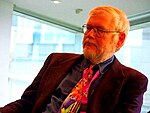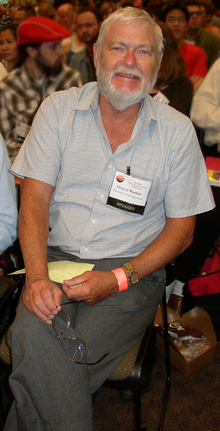Gregory Benford
Gregory Benford | |
|---|---|
 | |
| Born | January 30, 1941 Mobile, Alabama, U.S. |
| Occupation | Physicist, writer |
| Education | University of Oklahoma (BS) University of California, San Diego (MS) |
| Genre | Science fiction, hard science fiction |
| Notable works | Galactic Center Saga novels |
| Spouse | Joan Abbe (died 2002) Elisabeth Brown |
| Children | 2 |
Gregory Benford (born January 30, 1941) is an American science fiction author and
Benford wrote the Galactic Center Saga science fiction novels, beginning with In the Ocean of Night (1977).[2] The series postulates a galaxy in which sentient organic life is in constant warfare with sentient electromechanical life.
In 1969 he wrote "The Scarred Man",[3][4] the first story about a computer virus (based on a real computer virus he had spread[5]),[6] published in 1970.
Biography
Benford was born in Mobile, Alabama and grew up in Robertsdale and Fairhope.[7] Graduating Phi Beta Kappa, he received a Bachelor of Science in physics in 1963 from the University of Oklahoma in Norman, Oklahoma, followed by a Master of Science from the University of California, San Diego in 1965, and a doctorate there in 1967. That same year he married Joan Abbe, with whom he had two children.[8] Benford modeled characters in several of his novels after his wife, most prominently the heroine of Artifact. She died in 2002.[9]
Benford has an identical twin brother,
He has been a long-time resident of Laguna Beach, California.[8]
Writing career
Gregory Benford's first professional sale was the story "Stand-In" in the
Benford tends to write
Benford has served as an editor of numerous alternate history anthologies, as well as collections of Hugo Award winners.
He has been nominated for four Hugo Awards (for two short stories and two novellas) and 12 Nebula Awards (in all categories). In addition to Timescape, he won the Nebula for the novelette "If the Stars Are Gods" (with Eklund). In 2005 the MIT SF Society awarded him the Asimov Prize.[citation needed]
Benford was a guest of honour at
In 2016 Benford was the recipient of the Los Angeles Science Fantasy Society Forry Award Lifetime Achievement Award in the Field of Science Fiction.[12]
Contributions to science and speculative science

Gregory Benford is Professor Emeritus of Physics at the
Benford's work in physics at the University of California focused on theoretical and experimental
In 2004, Benford proposed that the harmful effects of
Benford serves on the board of directors and the steering committee of the Mars Society.
He has advocated human cryopreservation, for example by signing an open letter to support research into cryonics,[18] being a member of Alcor,[19] and by being an advisor to a UK cryonics and cryopreservation advocacy group.[20]
Gregory Benford retired from the University of California in 2006 in order to found and develop Genescient Corporation. Genescient is a new generation biotechnology company that claims to combine evolutionary genomics with massive selective screening to analyze and exploit the genetics of model animal and human whole genomes.
Scientific awards and recognition
This section of a biography of a living person does not include any references or sources. (February 2019) |
- Phi Beta Kappa
- Woodrow Wilson Fellow
- Fellow of the American Physical Society
- Visiting Fellow
- Cambridge University
- University of Turin
- University of Bologna.
- 1995 Lord Prize for contributions to science
- 2006 Professor Emeritus at the University of California, Irvine
Benford's law of controversy
Benford's law of controversy is an adage from the 1980 novel Timescape:[21]
Passion is inversely proportional to the amount of real information available.[22][23]
The adage was quoted in an international drug policy article in a peer-reviewed social science journal.[24]
Selected bibliography
Galactic Center Saga
- In the Ocean of Night (1977)
- Across the Sea of Suns (1984)
- Great Sky River (1987)
- Tides of Light (1989)
- Furious Gulf (1994)
- Sailing Bright Eternity (1996)
- "A Hunger for the Infinite" a novella published in the 1999 anthology Far Horizons
References
- Reason
- ^ Witcover, Paul (2000-03-20). "Mean, stupid, ugly, and the terror of all other species". Sci Fi Weekly. Archived from the original on 2009-03-04. Retrieved 2008-08-06.
- OCLC 44128776., cited at "The Scarred Man Returns". Gregory Benford. Retrieved 13 Feb 2017.
- ^ Benford, Gregory (May 1970). "The Scarred Man". Venture Science Fiction. pp. 122–132. Republished on author's website at http://www.gregorybenford.com/extra/the-scarred-man-returns/ .
- ^ Afterthoughts, 1999
- ISBN 978-1-60239-998-3.
- ^ Down the River Road — the Introduction | GREGORY BENFORD Retrieved 2011-11-16.
- ^ a b McLellan, Dennis (August 28, 1994). "The Science of Fiction : UCI Astrophysicist Gregory Benford Puts Reality Into His Novels". Los Angeles Times. Irvine. Retrieved 13 December 2015.
- ^ "Other Obituaries," Locus, May 2002, p.70
- ^ "ISFDB – James Bedford"
- ^ "Evil and Me", Benford; in 50 Voices of Disbelief: Why We Are Atheists
- ^ Publications, Locus (3 October 2016). "Locus Online News » Benford Wins Forry Award". www.locusmag.com. Retrieved 2016-10-03.
- on the paper can be found on Landis' website.
- Solar radiation management§Dispersive solutions.
- ^ See footnote 23 in E. Teller, L. Wood, and R. Hyde, "Global Warming and Ice Ages: Prospects for Physics-Based Modulation of Global Change" Archived 2007-06-16 at the Wayback Machine.
- ^ E. Teller, L. Wood, and R. Hyde, "Global Warming and Ice Ages: Prospects for Physics-Based Modulation of Global Change" Archived 2007-06-16 at the Wayback Machine.
- ^ Comments at the 64th World Science Fiction Convention, August 2006.
- ^ "Scientists Open Letter on Cryonics". Archived from the original on 2016-08-26. Retrieved 2016-02-02.
- ^ "Alcor Member Profile: Gregory Benford". Retrieved 2016-02-02.
- ^ "UK Cryonics and Cryopreservation Research Network". Retrieved 2016-02-02.
- ISBN 978-0-553-29709-6.
- ^ "EFF Quotes Collection 19.6". Electronic Frontier Foundation. 2001-04-09. Archived from the original on 2012-10-28.
- ^ "Quotations: Computer Laws". SysProg. Archived from the original on 2008-08-22. Retrieved 2007-03-10.
- S2CID 144452566.; official archival copy requires site registration. The article is a followup to pieces the author already published in Science (1997) and the Annual Review of Psychology (1998)
External links
- Gregory Benford official website Archived 2022-04-11 at the Wayback Machine
- Gregory Benford at the Internet Speculative Fiction Database
- Gregory Benford at IMDb
- Appearances on C-SPAN
- Giant rotating space lens, a possible engineering solution for global warmingproposed by Benford in 2004
- "Terraforming Ganymede with Robert A. Heinlein" by Gregory Benford: part 1, part 2
- Homepage at UCI
- List of works at Fantastic Fiction
- "Killer Bs" (Brin, Benford, Bear, Baxter and B-, er, Vinge) mailing list
- 2012 Interview at Locus (magazine)
- The Gregory Benford Papers (74.25 linear feet) housed at the Eaton Collection of Science Fiction and Fantasy Archived 2018-02-02 at the Wayback Machine of the University of California, Riverside Libraries.
